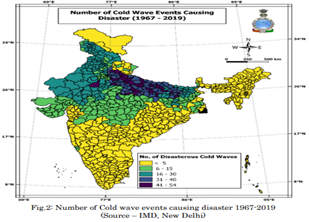Geography
Context: Recently Indian Metrological Department (IMD) has forecasted severe cold wave conditions in some parts of Punjab, Haryana, Chandigarh, Delhi, north Rajasthan, Himachal Pradesh and Uttarakhand.
About Cold Wave:

- It is a condition signify a certain amount of fall of temperature at given places with respect to climatological value.
- In India, cold waves are seen between November to March.
- However, minimum temperatures drop below 8°Cover many parts of northern India during the months of November to February.
- Impact on human health: It varies from Cough and cold, bronchitis and respiratory diseases, Blood pressure issues, Skin problems, and even Bone, joint, and muscle pain due to lack of sunlight.
Criteria for Cold Wave by IMD:
- It is considered when the minimum temperature of a station is 100°C or less for plains and 0°C or less for Hilly regions.
- Based on Departure
- Cold Wave: Negative Departure from normal is 4.5°C to 6.4°C
- Severe Cold Wave: Negative Departure from normal is more than 6.4°C
- Based on Actual Minimum Temperature (For plain stations only)
- Cold Wave: When minimum temperature is ≤ 04°C
- Severe Cold Wave: When minimum temperature is ≤ 02°C
- When minimum temperature departure is -4.5°C or less over a station, “Cold Wave” may be described if the minimum temperature is 150°C or less.
Factors responsible for cold wave in India:
- Build-up of a ridge (an extended area of relatively high atmospheric pressure) in the jet stream over northwest Asia.
- Movement of cold air masses in response to steering by upper-level winds.
- Formation of surface high-pressure over north & central India.
- Triggering mechanism like a strong westerly wave approaching northwest India to enhance winds for transport cold air south eastward.
- Extensive snow covers over northwest Himalayas.
Source: Indian Express
Previous Year Question
Q.1) In the northern hemisphere, the longest day of the year normally occurs in the: (2022)
- First half of the month of June
- Second half of the month of June
- First half of the month of July
- Second half of the month of July











